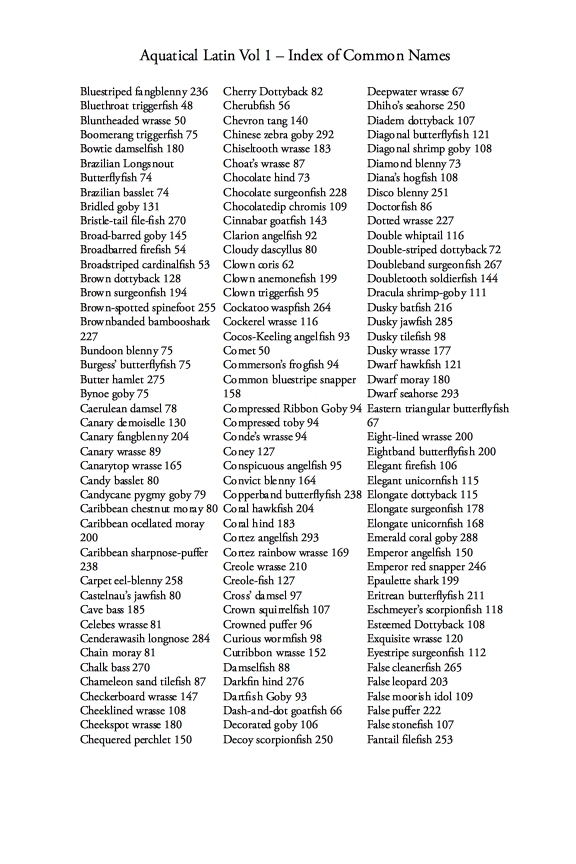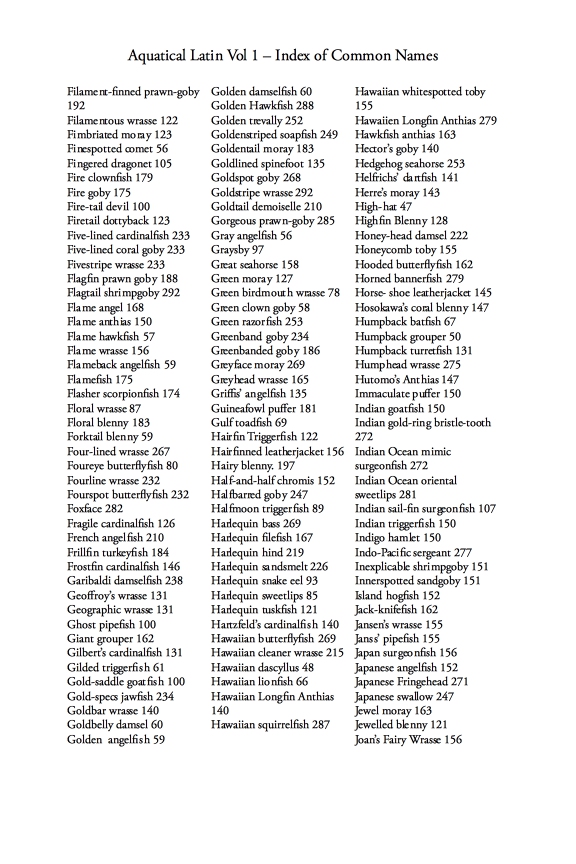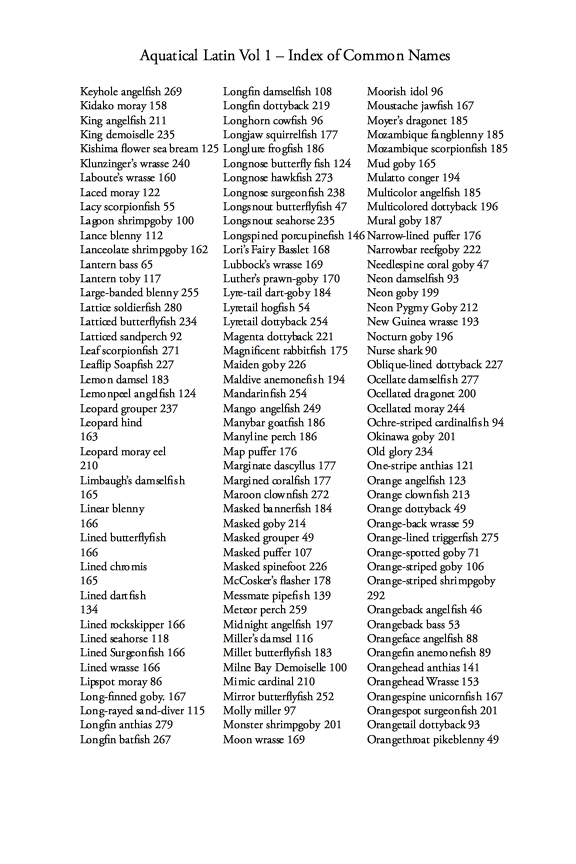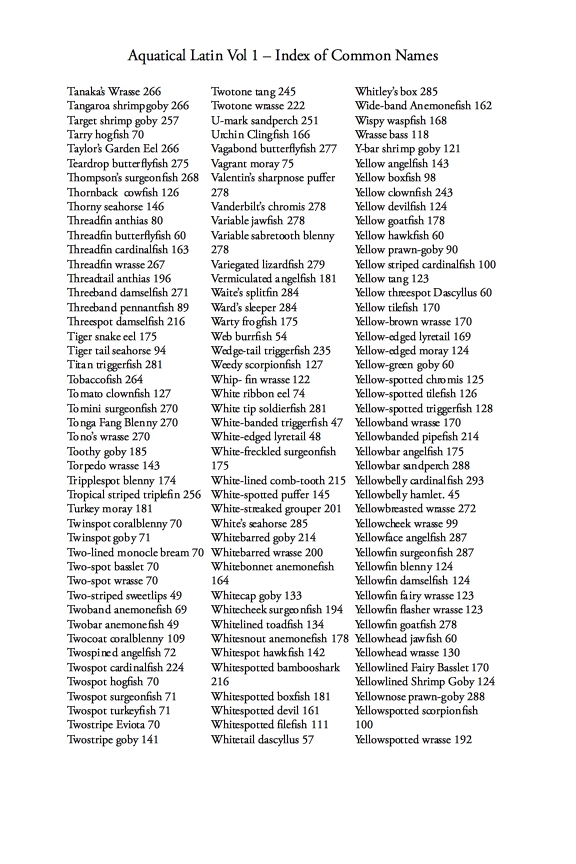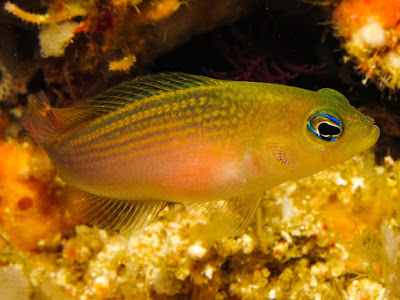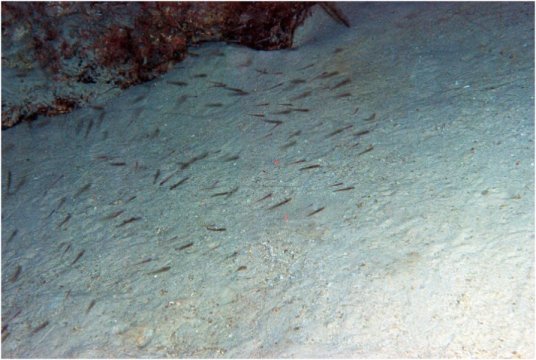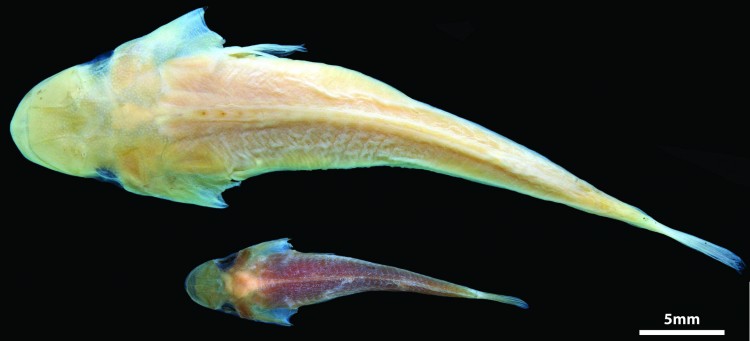Just added: an index to the common names of the fishes featured in AQUATICAL•LATIN Volume 1: Reef Fishes. Includes a free download of the index.
new
AQUATICAL•LATIN Vol 1 – Index of Common Names
As an aid to those unfamiliar with the scientific names of the fishes covered in AQUATICAL•LATIN Volume 1: Reef Fishes, I’ve prepared an addendum to the book in the form of an index of common names.
You can download a pdf of the index at the same size as the book here: Aquatical Latin Vol 1 – Index of Common Names. This will take you to a new page, click on the highlighted text to download the index.
AQUATICAL•LATIN official book launch.
We’re pleased to announce that we’re throwing an official book launch party for AQUATICAL•LATIN.
We’re especially proud that the launch party will take place at a prestigious literary venue, the Samuel Johnson Birthplace Museum in Lichfield (Breadmarket Street, Lichfield, WS13 6LG)
All are welcome to come along and meet the author and have a slice of cake and a cup of tea.
The launch party takes place on Saturday the 16th December between 2.00 and 3.00 pm.
Two new species of tropical reef fishes.
Aquatic scientific names in the news …
Two new species of tropical reef fishes have been recently described in the journal, Zootaxa.The first is a new species of Dottyback from Indonesia, Pseudochromis stellatus
The second species is an anthiadine serranid, or ‘Anthias‘ from the Ogasawara and Mariana Islands.
 Pseudanthias tequila, Image: N. Tsuji.
Pseudanthias tequila, Image: N. Tsuji.
Etymology
Pseudochromis stellatus Gill, Allen, & Erdmann, 2017, the Greenhead Dottyback.
Pseudochromis – Greek, Pseudo-, pseudes (ψευδης), false; -chromis (χρομις), genus Chromis, referring back to the Greek, Chromis, a sea-fish (classical).
stellatus – Latin, set with stars, starry. “The specific epithet is from the Latin, meaning starry or starred, and alludes to the yellow spots on the upper part of the body. The name was selected by high school students as part of a science activity in the Macleay Museum.” *
Pseudanthias tequila Gill, Tea, & Senou, 2017, the Cave anthias (Japanese name: Bonin-hanadai.
Pseudanthias – Greek, Pseud-, pseudes (ψευδης), false; -anthias (ανθιας), a catch-all common name for fishes of the Anthiinae, referring back to the Greek, Anthias , a sea-fish (classical).
tequila – Spanish, a distilled alcoholic drink, named for the town in Mexico where it was originally made. “The specific epithet refers to the alcoholic beverage tequila sunrise, alluding to the vibrant life colours of the males of the species. *
AQUATICAL•LATIN – the Book!
Available now – the first AQUATICAL•LATIN book:
AQUATICAL•LATIN
Latin for Aquarists
An Etymology of Tropical Marine Reef Species.
by
T. M. Hayes
This first volume takes a look at the etymology, that’s the meaning behind the names, of around 950 species of the most common tropical marine fishes found in the aquatic hobby.
In addition to being an etymological dictionary of species and genus names AQUATICAL•LATIN also looks at subjects such as taxonomy, explains all about scientific names, and includes a handy guide to how these sometimes peculiar looking names should be pronounced.
The perfect gift for the curious aquarist, a useful tool for public aquariums, academics, and an indispensable addition to any aquarist’s library.
AQUATICAL•LATIN is a unique book, it is the only available general etymological work on fishes. Written by marine aquarium writer Tim Hayes. this is an extensively researched and well referenced work.
Product details:
To purchase a copy of AQUATICAL•LATIN please go to the Amazon website
For more information about AQUATICAL•LATIN, the book, please contact AQUATICAL•LATIN via queries@aquaticallatin.info and we’ll do our best to answer your query.
New Species of Ocean Sunfish
Aquatic scientific names in the news …
A new species of Ocean sunfish has been described in the paper, Hiding in broad daylight: molecular and morphological data reveal a new ocean sunfish species (Tetraodontiformes: Molidae) that has eluded recognition, published in the Zoological Journal of the Linnean Society.
 Marianne Nyegaard with a beached hoodwinker sunfish. Image: Murdoch University
Marianne Nyegaard with a beached hoodwinker sunfish. Image: Murdoch University
The new species, Mola tecta, is the result of a four year search centred around genetic sequencing. During her research Marianne Nyegaard analysed more than 150 samples of sunfish DNA, her results indicated that the samples belonged to four distinct species, Masturus lanceolatus, Mola mola, and Mola ramsayi along with a fourth unknown species. The search for the unknown species was carried out by looking at pictures of sunfish on social media as well as pictures sent by observers from New Zealand and Australian fisheries in an attempt to find photographs of a previously undescribed sunfish
In 2014 a small specimen was found tangled up in fishing line, it was hauled out of the water to be freed, photographed and a genetic sample was taken. The search culminated with four fish being stranded in one go on the same beach in New Zealand.
Ultimately enough fish were found to describe this species ranging in size from 50cm to nearly 2.5m. Unlike the other species, they don’t develop lumps and bumps as they grow. Their back fin is separated into an upper and lower part, with a small flexible piece of skin, which has been termed the “back-fold”, connecting the halves.
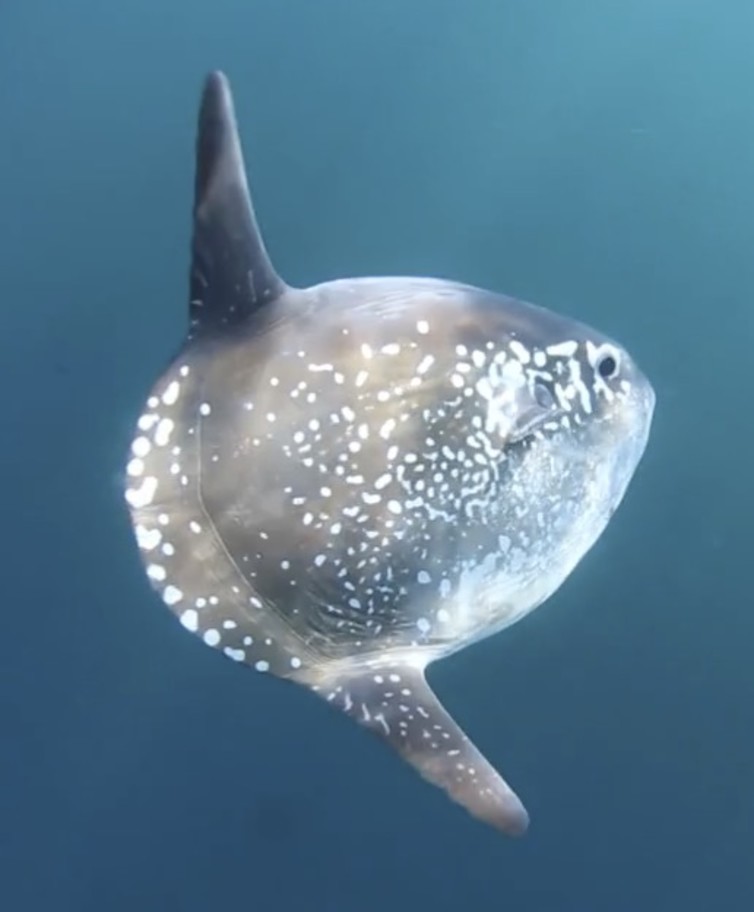 Hoodwinker sunfish off the coast of Chile. Image: César Villarroel, ExploraSub
Hoodwinker sunfish off the coast of Chile. Image: César Villarroel, ExploraSub
Sunfish aren’t particularly rare, but they’re tricky to study as they live in parts of the ocean most humans don’t go. Their exact range is unknown but it seems to be the colder parts of the Southern Hemisphere. They’ve been found all around New Zealand (mostly around the South Island), off Tasmania, South Australia, Victoria and New South Wales (Australia), South Africa and southern Chile.
It seems likely that, given its size, this will be the largest new species to be described this year.
Etymology.
Mola tecta Nyegaard, 2017, the Hoodwinker sunfish
Mola – Latin, mill, millstone; grinders, molar-teeth. Alluding to the to the fact that the fish is similar in shape to a millstone (G. Rondelet De Piscibus Marinis1554).
tecta – Latin, hidden; secret, concealed, disguised. Name alluding to the species having been hiding in plain sight for centuries.
See also: Ocean sunfish.
Headstanders
Aquatic scientific names in the news …
Two new species of fish, one from the Orinoco river drainage the other from the Xingu river of Brazil, have been described by a team of scientists from Oregon State and Brazil in a paper published in the journal Neotropical Ichthyology.
The species of fish from the Orinoco River drainage, Leporinus enyae, has been named in honour of the Irish singer and songwriter Enya and her song Orinoco Flow, a song often played in the lab at Oregon State University where some of the scientists were working and which was felt to be appropriate tribute to the songwriter.
 Leporinus enyae Image: José Birindelli.
Leporinus enyae Image: José Birindelli.
The second newly discovered fish, Leporinus villasboasorum, has been named in honour of the pioneering efforts of the Villas-Bôas brothers, Orlando, Cláudio and Leonardo. In 1961 they succeeded in getting the entire upper Xingu legally protected, the first indigenous park in South America, leading to dozens of further parks being created around the continent.
Leporinus is the largest and most diverse genus in the characiform family Anostomidae and includes roughly 90 species across most of South America. Many species swim in an oblique head-down position earning the family the common name of Headstanders. Most species are herbivores or detritivores and they occur throughout South America with the exception of the east Andes. Both new species are comparatively small, around 20 to 25 cms long, although larger members of their family can reach a length of 60 cms. Some smaller members of the family make their way into the aquarium trade.
The term Leporinus literally means “little hare,” in reference to the large teeth that protrude from the mouth, much like those of a rabbit. The bottom teeth of the two new species are particularly long, and while no one is sure why, the researchers note that it may relate to their foraging on plants, worms and other invertebrates.
Etymology
Leporinus enyae Burns, Chatfield, Birindelli, & Sidlauskas, 2017
Leporinus – Latin, of or like a hare (classical – Pliny). Named in allusion to the large teeth that protrude from the mouth, much like those of a rabbit.
enyae – Eponym. “Named in honor of the singer Enya, whose beautiful song “Orinoco Flow” celebrates the flow of the mighty Orinoco River, which the new species inhabits.”*
Leporinus villasboasorum Burns, Chatfield, Birindelli, & Sidlauskas, 2017
Leporinus – As above.
villasboasorum – Eponym. “Named in honor of Orlando, Cláudio and Leonardo Villas-Bôas, in recognition of their pioneering efforts to conserve and protect the rio Xingu’s marvelous biodiversity, of which Leporinus villasboasorum forms part.”*
*Systematic assessment of the Leporinus desmotes species complex, with a description of two new species. Michael D. Burns, Marcus Chatfield, José L. O. Birindelli and Brian L. Sidlauskas, 2017
Ember Goby
Aquatic scientific names in the news …
10th June 2017
The Ember Goby
This new species, subsequently described as Palatogobius incendius, was observed and collected over the course of several submersible dives off the coasts of Curaçao and Dominica between 2013 and 2016 as part of the DROP project (see below). During this same time lionfish predation of the then undescribed species of goby was also observed and recorded by the Curasub submersible. The description of both the new species and the lionfish predation can be found in “A new mesophotic goby, Palatogobius incendius (Teleostei: Gobiidae), and the first record of invasive lionfish preying on undescribed biodiversity” at PLOS One.
Palatogobius incendius, live in an aquarium. Image: Barry Brown.
Specimens of Palatogobius incendius, were collected by the Curasub using the two hydraulic arms, one equipped with a quinaldine-ejection system to anesthetize fishes, and the second equipped with a suction hose to collect immobilized individuals. Captured specimens were stored in a vented acrylic container for transport to the surface. The depth range from which these fishes were collected from is termed mesophotic, a term used to describe coral reefs growing from around 30 m down to around 150 m in both tropical and subtropical water.
Mesophotic, a modern scientific term derived from ancient Greek, Meso-, mesos (μεσος), middle; and phot- (φωτ-, φῶς), light; -ic, suffix meaning after the manner of, of the nature of, pertaining to, of.
Image: School of Palatogobius incendius at type locality, sta. CURASUB15-30, 152 m depth, Curacao.
Palatogobius incendius has been collected on deep reefs at depths of 88 to 200 metres from Curacao and Dominica and observed off Roatan, Honduras. The species occurs exclusively in hovering schools ranging in size from as small as 5 to 10 individuals (rare) up to 50 to 200 individuals. Schools are most frequently found at the top or bottom of vertical walls off Curaçao and Dominica, but off Roatan more than a dozen schools of P. incendius were observed collectively comprising as many as 1000 individuals over a long, gradually inclining stretch of sand and small rocks from around 150 to 170 m depth. Schools of P. incendius generally comprise individuals at multiple life stages, ranging from moderately developed larvae to adults. Off Dominica larger swarms of minuscule fish (about 5 mm TL) were also observed, possibly very recently recruited P. incendius larvae, given their size, abundance and depth range. Individuals in these swarms were too small to be captured, and were observed traveling only a few cm off the bottom rather than hovering in a cloud well above the substrate. These schools of post-larvae were 1–2 m wide and up to 5 m long, and moved steadily upslope at approximately 0.15 m/s, navigating laterally around obstacles in a fashion superficially similar to a wide chain of marching army ants.
The schooling behaviour of Palatogobius incendius may be leaving them open to the danger of lionfish predation, with their schools being easily driven or corralled by the lionfish into corners of the reef where they are vulnerable to predation.
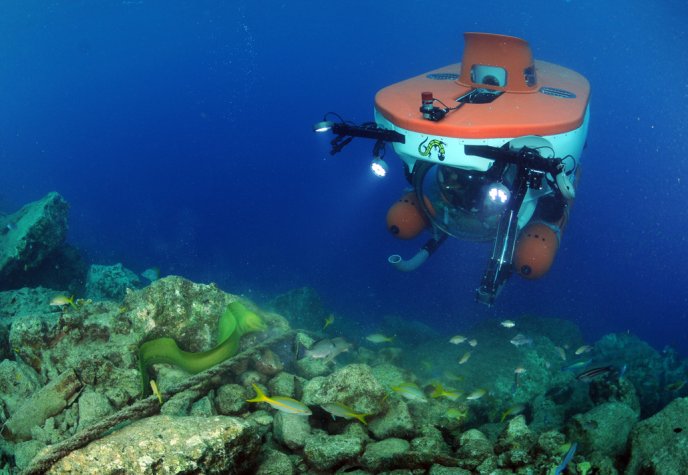 Curasub Image: Nuytco Research
Curasub Image: Nuytco Research
In recent years the Smithsonian’s Deep Reef Observation Project (DROP) has contributed a significant body of information on the taxonomic makeup of deep-reef fish communities in the Caribbean. Through the use of Substation Curaçao’s (www.substation-Cuaracao.com) manned submersible, the Curasub, DROP researchers have described many new species of deep-reef fishes, including several that may be susceptible to lionfish predation due to their body size, shape, and behavior.
That a previously unknown species was collected for the first-time whilst simultaneously being found to be susceptible to predation by invasive lionfish species raises the question of how many other new species are in danger before they’ve been discovered. The greater depths where these new species are being discovered is also the reason behind their discovery. Depths beyond the range of conventional scuba diving are being opened up to discovery through the new technology of submersibles such as the Curasub and through new advanced diving techniques, unfortunately these greater depths also represent an environment where the lionfish feels at home.
Lionfish are invasive species from the Indo-Pacific, likely introduced into Atlantic waters through the marine aquarium trade either as escapees or as released specimens. They are primarily crepuscular hunters, and hunt more actively on overcast days with less light and at greater depths. In the western Atlantic lionfish are tolerant of, and thrive at, the cooler temperatures of the deeper reefs, where they have become locally abundant. This is especially concerning for native deep-reef fishes that occur from 50–300 m, where reduced light conditions may make them more susceptible prey for actively hunting lionfishes.
The composition of these deep-reef fish communities differs from that of shallow reefs, and is made up primarily of a unique fauna that includes many undescribed species. This results in a community of poorly known or undescribed species that may be negatively affected by invasive lionfish. To date little is known about the lionfish predation on deep-reef fish assemblages.
Etymology
Palatogobius incendius Tornabene, Robertson & Baldwin, 2017, the Ember Goby.
Palatogobius – Latin, Palat-, palate, roof of the mouth; -o-, connective vowel; –gobius, a fish of small value, the gudgeon (classical); a fish belonging to the family Gobiidae (modern). “The generic name Palatogobius is in reference to the teeth that may be present on the roof of the mouth.”
incendius – Latin, incendium, a burning, fire, conflagration. “The specific epithet incendius is an adjective formed from the Latin root incendium meaning ‘fire.’ The scientific and proposed common names refer to the bright orange, yellow and reddish-pink coloration on the body, head and fins.”
ESF Top 10 New Species list 2017
Aquatic scientific names in the news …
A species of freshwater stingray, Potamotrygon rex, a swimming centipede Scolopendra cataracta, and a marine worm Xenoturbella churro, all feature in this year’s ESF Top 10 New Species list.
The list, an annual event established in 2008, is compiled by ESF’s International Institute for Species Exploration and comprises the Top 10 species from among the thousands of new species named during the previous year, selected by an international committee of taxonomists and calls attention to the fact that new discoveries are being made even as species are going extinct faster than they are being identified.
The list is published around May 23 each year to coincide with the birthday of Carolus Linnaeus, the father of modern taxonomy.
Potamotrygon rex Carvalho 2016
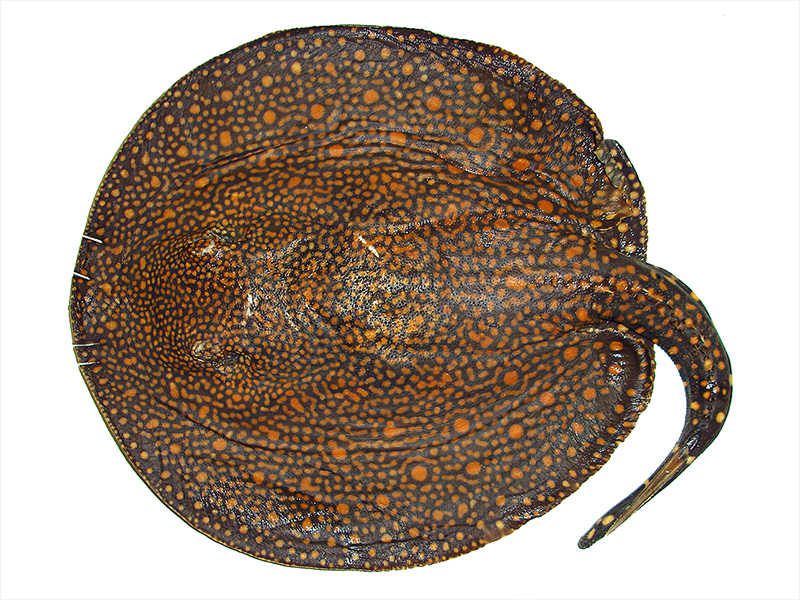 Dorsal view of juvenile specimen
Dorsal view of juvenile specimen
Image: Marcelo R. de Carvalho
This large, strikingly patterned freshwater stingray is endemic to the Tocantins River in Brazil and is among the 35 percent of the 350 documented fish species in the Tocantins River that are found nowhere else on Earth. The type specimen is 1,110 mm in length. Large specimens may weigh up to 20 kg.
The stingray has a blackish to blackish-brown background colour, with intense yellow to orange spots that, combined with its size, earn it the title “king.” The discovery of such a large and brightly coloured ray highlights how incompletely we know fishes of the Neotropics.
Etymology
Potamotrygon – Greek, Potamo-, potamos (ποταμος), river, stream; Latin, –trygon, (Greek τρυγων) a stingray.
rex – Latin, absolute monarch, king – named for its large size and striking color pattern
Scolopendra cataracta Siriwut, Edgecombe & Panha, 2016 – Waterfall Centipede or Swimming Centipede
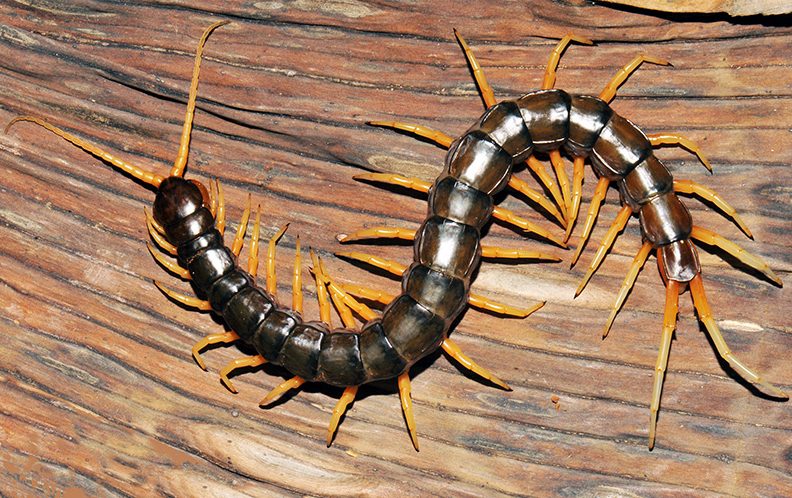 The largest reported centipede, with a maximum recorded body length of around 20 cm.
The largest reported centipede, with a maximum recorded body length of around 20 cm.
Image: Siriwut, Edgecombe and Panha
This new centipede is black, has 20 pairs of legs and is up to 20 cm in length. It is the first species of centipede ever observed to be able to plunge into water and both run along the stream bed, in much the same manner as on dry land, and swim with eel-like horizontal undulations of its body. It would appear to have a hydrophobic surface as out of water, water rolls off the centipede’s body leaving it totally dry.
The species, with its surprisingly adept swimming and diving abilities, was discovered under a rock but escaped into a stream where it rapidly ran to and hid under a submerged rock. A member of the predominant centipede genus in tropical regions, the centipede’s amphibious ability is unprecedented. Its population status is of concern because of habitat destruction, including tourist activities, along streams and river embankments where the new species is found.
Etymology
Scolopendra – Latin, (Greek σκολοπενδρα), a kind of multipede, millepede.
cataracta – Latin, a waterfall. Named for the Tad E-tu Waterfall where the type was collected
Xenoturbella churro Rouse, Wilson, Carvajal & Vrijenhoek, 2016
Discovered deep in the Gulf of California, 1,722 meters below the surface, Xenoturbella churro is a 10 cm-long marine worm, one of half a dozen species now known in the genus. It is representative of a group of primitive worm-like animals that are the earliest branch in the family tree of bilaterally symmetrical animals, including insects and humans. Like some of its relatives it’s believed to feed upon mollusks, such as clams. Curiously, much like coelenterates (corals, anemones, etc.) they have a mouth, but no anus.
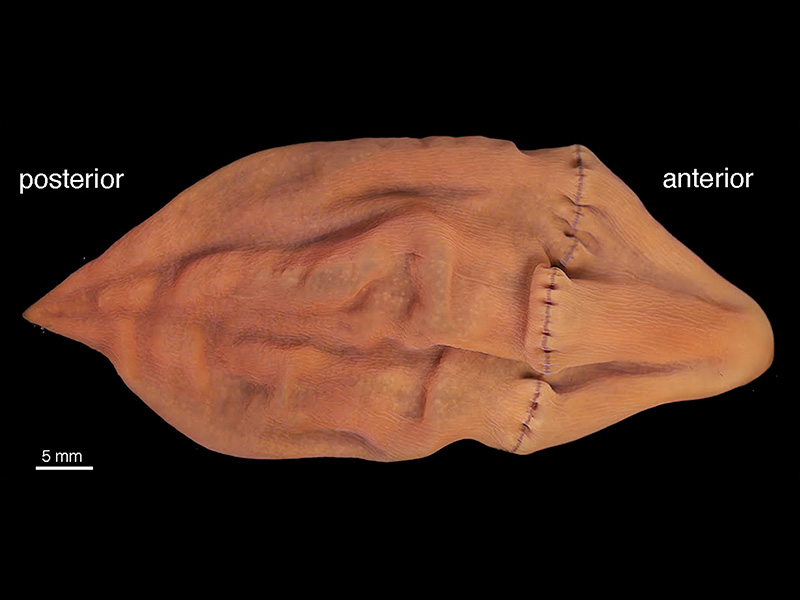 Dorsal view. Image: Greg Rouse
Dorsal view. Image: Greg Rouse
Etymology
Xenoturbella – Greek, Xeno-, xenos (ξενος), a guest, stranger, foreigner; foreign, strange; Latin turbella a little crowd, a bustle, stir, diminutive of turba crowd – referring to the cilia which produce minute whirls in the water.
churro – Spanish, a type of fried pastry. The new species is uniformly orange-pink in color with four deep longitudinal furrows that reminded the authors of a churro, a fried-dough pastry popular in Spain and Latin America.
See also: ESF Top 10 New Species list 2016
New Species of Clingfish
Aquatic scientific names in the news …
25th April 2017
The Duckbilled Clingfish
A new species of clingfish has been described in the journal Copeia.
Clingfishes are fishes belonging to the family Gobiesocidae. They possess modified pelvic fins that form a suction disc which enables them to cling to objects such as rocks, algae, and seagrass in areas of surge, and even to the bodies of larger fish.
Generally small fish (most species less than 7cm in length), they inhabit shallow water throughout tropical and temperate seas, and are particularly found in the Atlantic, Pacific and Indian Oceans.
They typically have scaleless tapering bodies with a single dorsal fin and a flattened head, cryptic colouration, and a thick layer of protective mucus (toxic in some species). A number of species live in association with sea urchins or crinoids.
This new species is remarkable for the extraordinary number of teeth it possesses. Whereas previously described clingfishes may exhibit something in the region of 100 to 200 teeth Nettorhamphos radula is estimated to have as many as 1800 to 2300 teeth. These are laid out in 15 regular rows along each side of the upper jaw (40 to 50 teeth per row) and 10 regular rows along each side of the lower jaw (30 to 40 teeth per row), as opposed to the more usual small patch of teeth tapering off to a single row in both upper and lower jaw seen in the majority of other species.
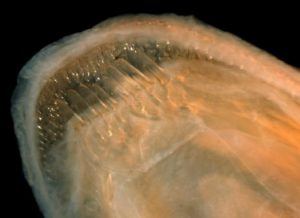 Close up of the teeth. Image: Conway and Moore
Close up of the teeth. Image: Conway and Moore
Two specimens of the new species were discovered in the collection of the Western Australian Museum. They were previously undescribed specimens collected at a depth of 30 – 40 metres in a 1977 trawl of algae and sponge covered reefs offshore of Fremantle, Western Australia.
Etymology
Nettorhamphos radula Conway, Moore 2017, the Duckbilled Clingfish.
Nettorhamphos – Greek, Nett-, nhtta (νηττα), duck; -o-, connective vowel; –rhamphos, ramphos (ραμφος), bill, beak.
radula – Latin, a scraping-iron, scraper. “In reference to the many tiny conical teeth on the lingual surface of the premaxilla and dentary, which are reminiscent of the radula of a snail.”
Ref. Conway, Moore, and Summers 2017. A New Genus and Species of Clingfish (Teleostei: Gobiesocidae) from Western Australia

